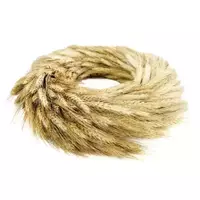Triticale

A new culture with the mysterious name triticale became known to domestic farmers only a few decades ago, and since that time, specialists in this field have begun to actively engage in the selection of this previously unknown grain. Gradually, commercial varieties of triticale appeared in our country.
This amazing plant is a hybrid of wheat and rye, while being considered a completely new botanical species. Triticale appeared as a result of crossing hard and soft wheat with winter rye. Today, triticale is a promising bread crop that is excellent for producing starch, making mixed feed, as well as producing malt and bakery flour.
The very name of this culture is formed by the addition of parts of 2 words: triticum (wheat) and secale (rye). The cereal is highly productive, as it is characterized by high spikiness of the spike. Today, winter and spring triticale varieties are distinguished. This cereal crop is cultivated in many countries of the world, and the leader is Poland, and among the countries of the former CIS, triticale has become the most widespread in Belarus.
Undoubtedly, the clear interest in triticale is due to the great possibilities of culture. So, for example, cereal has an excellent yield potential, increased frost resistance, resistance to viruses and fungi. Triticale tolerates drought and freezing well, while this crop is successfully cultivated in places where the growth of traditional winter wheat varieties is very difficult.
The main part of the triticale crop is used for the production of feed, but the hybrid is quite widely used in the confectionery, fermentation industry and, of course, in the bakery. By the way, this cereal crop is often used even for the manufacture of ethyl alcohol and biological liquid fuel.
Due to the specific properties of gluten proteins, triticale flour is widely used in confectionery. Many products, for example, cookies, muffins, gingerbread products from such flour are of higher quality than products based on pure wheat flour. In addition, baking from triticale flour is distinguished by high taste and, moreover, is much slower to stale.
The high nutritional value of products from this culture is due to the presence of a protein that contains an increased amount of amino acids. In addition, it contains such essential substances as glycine, lysine, threonine, valine, arginine and some others. Thus, triticale grains contain about three to four percent more protein than rye grains and one and a half percent more than wheat.
triticale 336 kCal
Energy value of triticale (Ratio of proteins, fats, carbohydrates - ju):
Proteins: 13.05 (~ 52 kCal)
Fats: 2.09 (~ 19 kCal)
Carbohydrates: 72.13 g (~ 289 kCal)
Energy ratio (b | y): 16% | 6% | 86%
 Español
Español Français
Français Português
Português Русский
Русский 简体中文
简体中文 繁體中文
繁體中文 日本語
日本語 한국어
한국어 العربية
العربية Türkçe
Türkçe Қазақ
Қазақ Deutsch
Deutsch Italiano
Italiano Українська
Українська
